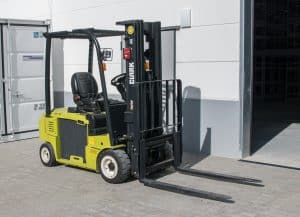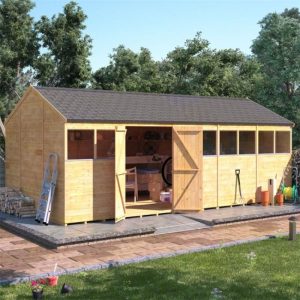How To Move Garden Shed
Whether you've just moved house or you're rearranging your existing garden, even the thought of moving a garden shed can be exhausting and daunting.
Transporting a garden building to a new location may seem impossible, but it actually happens more than you would think. Even though it can be risky, it is achievable – even without any specialist equipment.

At Garden Buildings Direct, we've got over 20 years of experience in the industry, so know what it takes when it comes to moving a garden shed.
With a few simple tools, an extra hand and no big expenses, you can follow the DIY approach that we've put together in this article. Let's move your shed without breaking anything!

Why Move Your Shed?
Before we head into our step-by-step guide on how to move your shed, we've compiled below a list of reason why you might need to move your shed. If you're second-guessing your decision, or considering not bothering, check out the list. If your reason's on there, get moving!
Because of the Weather
So you just moved into your new home. A week later, you notice that the shed in the garden was put in a complicated spot by the previous owner. The current location sports a divot nearby which collects rainfall. This rain runs down a small slope and meets the shed at the base.
This situation could eventually end up degrading the foundation as well as damage any possessions inside. Check out our related posts on the right hand side for more information about how rain causes rot and other problems.
In situations like this, moving your shed into a better spot is your safest and best option.
You Want to Utilise Your Garden Space More
If you have a nice flat, house or property yard with a pre-done garden, lucky you! But that doesn't mean a bit of garden organisation is out of the question…
Maybe the position of the current shed means that you cannot access a certain part of the garden. Maybe the space isn't being used in the most efficient way. Optimising your backyard space can allow you to utilise your garden more functionally.
When it comes to reorganising, moving your shed may be the practical option for you to enjoy your outdoor living space more.
For Convenience
Making your shed stand out and be noticed in your garden is difficult. In order to get the best exposure, you're going to want it bathed in sunlight whenever possible. If your garden is filled with trees, brightening up your shed's interior can be tricky.
But what if it's the shed itself that's making a garden beauty spot look blue and somber? Whatever it is, there's only one answer – moving your shed. The ideal location can turn a dreary storage space into a spot in which you and your family can unwind and bask in the warmth of the sunshine on a summer's evening.
You Are Thinking About The Neighbours
Outdoor buildings, such as garden sheds, are considered permitted developments. Typically, they don't require planning permission for construction to get underway. Still, it's best to familiarise yourself with any potential local rules and regulations before installation.
If you've moved in and there's already a shed there in a precarious place, it might be worth moving it. The same goes for if you've just installed a shed yourself, without consulting any laws and legislation first.
Most planning authorities have at least some rule about how close your shed can be to your house or your fence. This is to try and prevent it infringing on anyone else's property. If your shed violates this guidance, your neighbours may have the right to lodge a complaint or press charges.
If you decide to keep your shed put, even after a warning from the council, you could face a hefty fine. But with this guide, you can prevent all that. These easy steps are curated by our experts, and will help you get your shed moved without fuss in no time, saving you from future worry.
Disclaimer: If you're planning to move your shed to another building but do not have a wide enough access path to get from your back garden to the road, you will have to dismantle your shed in order to move it. Unless you use a crane.
What you might need
- A trailer big enough to place your outbuilding on
- Log rollers
- Jacks or a forklift
- Straps to strengthen it
- Dolly – if you are moving your shed within the same yard
- Crane – for unloading a large-sized garden building
How to Move a Garden Shed Without Struggling
Let's get down to business and talk about how exactly you can move your shed from point A to B.
Step 1: Evaluate Your Shed's Movability
Keep in mind that not every shed is suitable for moving to a new property. It will depend on factors such as the size, weight, and material of your outdoor building. Working out how easy or difficult it will be is a perfect place to start.
We suggest measuring the dimensions of your shed first. If you purchased it pre-assembled, you should be able to check online for some measurements. You should also be able to find the building's empty weight online or in the instruction manual. If not, try giving customer services a ring (our number is 01909768840).
According to Dolly , your shed should fit into one of the five categories below:
- Moveable in a truck bed. Small sheds can fit into average-sized truck beds that are around 6' long. Small shed units are also light enough to be lifted by a group of people (unlike bigger units that normally require special equipment and longer truck beds). If you can find out the size of your shed, you'll be able to work out what size truck bed you'll need.

A forklift may be useful for lifting a small shed. - Moveable in a trailer. If your shed is over 8' long or wide and weighs more than a tonne, we recommend using a trailer.
- Moveable with a forklift. For garden sheds that weigh half a tonne, a mini forklift is a great tool. A downfall of this method is the experience you'll need to be able to drive and operate a forklift effectively. It might be worth enlisting some help from a licensed forklift operator if you're not well acquainted with a forklift yourself.
- Not moveable at all. If the shed is cemented into the ground, chances are you won't be able to move it. It's frustrating to have to leave a quality shed behind, but if you're moving into a new home, your best shot is probably to invest in a new one.
- Your shed can only be moved after disassembly . If you can take your shed apart, it could be worth doing so before you move it, to save on expenses incurred for experts and vehicles.
Step 2: Empty the Building Before Moving
Your shed may still weigh around 8 or 9 stone even with nothing in it. That might not seem too heavy, but it'll be awkward to move unless you're Mr. Tickle. Enlisting the help of friends or family members is paramount to a successful move.
We recommend emptying the building completely beforehand, to make it as light as possible. After that, move the items as far away from the shed as possible. This way, you'll have enough space to move the building without encountering any obstacles.
Step 3: Gather Your Supplies
If you wish to use the roll-over-pipes method, then you better prepare a dozen or more UVC pipes or any other suitable lightweight pipes. It is also best to have the basic tools on hand in case of any breakdown; your standard home toolkit should work.
If you own a medium-sized shed and you think a forklift or a heavy jack is needed to get it up out of the ground, head to your local rental centre and ask for professional help. It is better to have some extra muscle to help you out.
Step 4: Prepare the New Location as Well as Your Shed for Moving

Access to a clear path is critical in the transportation of your shed. This will ensure you don't trip over any obstacles that you can't see while transporting, which may include lumps of grass if the lawn is overgrown, or stones on a dirty path. For a seamless moving process, prepare the area, including the new spot for the shed, by raking the area and mowing the grass.
Once you've cleared any debris, it's time to prepare your shed. If possible, consider taking out the windows and removing the doors from their hinges to save them from being warped and twisted into odd positions during transportation. Put them aside and move them separately.
Step 5: Dig Your Shed Out
If your shed is anchored to the ground, you're going to want to get it out.
A shovel is a great tool for this. Experts suggest creating "gripping points" at periodical areas around the shed, by digging downwards to create divots in which you can put your hands, or a jack, to get a grip of the shed from underneath. You should do this at each corners of the shed, with each point being at least half a foot deep.

If your shed is on an uneven surface, take precautions and be careful, to avoid the shed from tumbling downhill.
Step 6: Moving Your Shed
If you have a small enough shed, you should be able to simply lever it up from the bottom with the help of few friends. It's your discretion how much help you need. That being said, regardless of whether your shed is plastic, metal or wooden, make sure to do the lifting with your legs, not your back, and go slowly.
If you've got a bigger shed, you might need to use a car jack. These mechanisms usually come in the form of a ledge than can be levered up via hydraulic pressure. The person involved pumps a lever which pushes the ledge (which has been wedged underneath the item you're wanting to lift up, such as a shed or a car) upwards.
Once your shed is raised enough to be able to get something underneath, it's time to move.
As mentioned in Step 1, some massive sheds are better moved using a forklift, some using a dolly, others a crane. But if you need to do it manually, the roll-over-pipes method is the most safe and secure.
Rolling over scaffolding pipes

The first thing you're going to need to do is to lay your hands on some scaffolding pipes. PVC or metal pipes that are about 4 inches in diameter should do the trick.
Slide these underneath the raised shed, perpendicular to the direction you want to move it. Place them around four feet apart. You should only need two-four poles. If the ground you're moving the shed along is very soft, and the poles may slip and slide, consider laying down two flat wooden beams parallel with the direction of movement, like train tracks.
Once the poles are underneath the shed, you can roll it along manually with some people pushing from the back and supporting at the front. If it's super heavy, you might want to use a vehicle with a winch to pull it along. As you roll it along, the pipes will eventually roll out at the back of the shed, one by one. As they do, assign one person to pick them up and reinstall them at the front of the shed.
You might also be rolling the shed along further than the distance of the wooden tracks you're using. Once they become free, move them to the front and continue the journey.
If you need to rotate the shed, try relaying your scaffolding poles parallel to the shed. Push it with more weight on one side to get it to rotate on an axis. The poles should assist in the rotation of the shed.
Step 7: Loading Your Shed Onto A Vehicle
Loading your shed onto a vehicle is probably the most difficult step in the process. Obviously, it only requires doing if you're moving the vehicle to a different property. If you're just moving it to a new location within the same garden, the job is already done!
Moving your shed onto a vehicle requires muscle power and concentration. There are a few different ways you can do this.
With a jack
If you can lever your shed up high enough with the jack, you can slide it straight onto the truck off the jack. Make sure you park the vehicle next to the building for easy access.
Using a forklift

Slide the forklift prongs under the raised shed and lift it on.
Up a ramp
If your vehicle has a ramp on it, you can potentially slide it up onto the pickup truck or trailer using brute human force. Position as many people as you can around the shed. A few at the back will need to push. Make sure they're strong and prepared, as a gradient that's too steep may cause the shed to fall backwards. Take the utmost care in this procedure.
Step 8: Transport and Move Your Shed
You've made it – the final step! If you're moving the shed to a new property, all you've got to do now is drive it there!
Once you arrive, repeat step six in reverse to unload the shed off the truck or van into position.
All that's left to do now is to put your outdoor equipment, furniture and gardening tools back in!
Things to Consider
- When lifting , make sure all sides are lifted equally.
- If you are using the roll-over pipes method, slide the first few pipes underneath while someone goes back to lift the rest of the shed.
- Take your time when doing any lifting or moving, to avoid any inconvenience and injury.
Hopefully, with this guide, we've answered some of your queries and calmed your qualms about the transportation of your shed. In most cases it is possible – so you don't need to worry about getting rid!
Shop Apex Workshops
How To Move Garden Shed
Source: https://www.gardenbuildingsdirect.co.uk/blog/how-to-move-a-shed/
Posted by: powellhinion.blogspot.com

0 Response to "How To Move Garden Shed"
Post a Comment